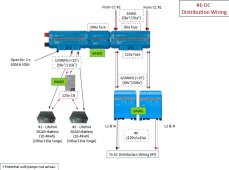I have 2 x 202AH 48v LifePo4 batteries currently, wired in parallel, no comms in/out of battery, 1.5 years old, no problems with them. I need/want to expand the battery bank but can no longer acquire existing brand batteries. I was looking at buying 2 x 100AH 48v LifePo4 batteries, wiring them together first to mimic a 48v 200AH battery, then add them in parallel with the existing batteries. But I have read 10 or so threads here on mixing batteries and I now have a question: Should I continue as planned or simply wire both of the new batteries in parallel with the existing batteries and forget about doing the "mimic" thing first?
OK, second question...If I simply add the two new batteries in parallel with the existing two batteries, won't they discharge first since they are only 100AH vs 202AH?
Also, I am open to any other advice, thoughts, and/or opinions
Specs -
BATTERIES
Existing Potential New
Capacity (a): 202AH 100AH
Capacity (kWh): 10.3kWh 5.12kWh
Rated Volt: 51.2v 51.2v
Volt Range: 44.8v - 58.4v 46.0v - 55.5v
Constant Charge Current: 100a 100a
Constant Discharge Current: 100a 100a
* Yes, it appears I would have to lower my bulk/float charge parameters to the lower settings for the "Potential New" but that would mean that the "Existing" would just take longer to charge.
OK, second question...If I simply add the two new batteries in parallel with the existing two batteries, won't they discharge first since they are only 100AH vs 202AH?
Also, I am open to any other advice, thoughts, and/or opinions
Specs -
BATTERIES
Existing Potential New
Capacity (a): 202AH 100AH
Capacity (kWh): 10.3kWh 5.12kWh
Rated Volt: 51.2v 51.2v
Volt Range: 44.8v - 58.4v 46.0v - 55.5v
Constant Charge Current: 100a 100a
Constant Discharge Current: 100a 100a
* Yes, it appears I would have to lower my bulk/float charge parameters to the lower settings for the "Potential New" but that would mean that the "Existing" would just take longer to charge.



